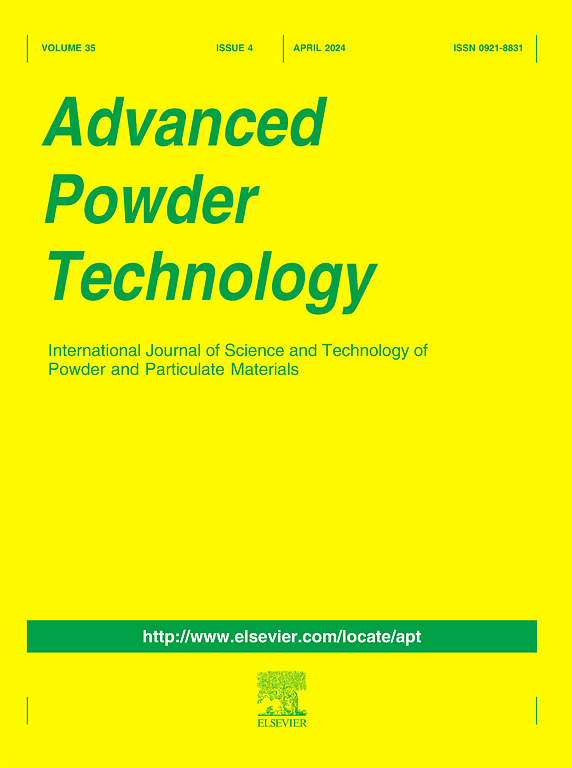通过腐蚀和侵蚀Al粗颗粒制备γ-AlOOH纳米粉体
IF 4.2
2区 工程技术
Q2 ENGINEERING, CHEMICAL
引用次数: 0
摘要
采用声化学腐蚀和侵蚀Al颗粒的方法,在室温下制备了薄水铝石(γ-AlOOH)纳米粉体。在N2H4·H2O中超声作用24 h后,Al粉末完全转化为γ-AlOOH纳米粉末。所得γ-AlOOH颗粒在0.1 M NaOH水溶液中的平均粒径为158.2 nm,比表面积为360.9 m2/g。而Al粉末在N2H4·H2O中磁搅拌30°C后,并没有得到γ-AlOOH粉末,说明声化学效应(热点、微射流和激波)显著促进了Al的腐蚀反应和表面侵蚀,从而形成了γ-AlOOH纳米晶体。研究了γ-AlOOH对刚果红(CR)的等电点和吸附速率。在pH为8.70的100 mg/L CR溶液中搅拌60 min后,γ-AlOOH纳米粉体的吸附量为100.0 mg/g。Al粉与N2H4·H2O的声化学合成工艺简单,是制备γ-AlOOH纳米粉体的较好方法。本文章由计算机程序翻译,如有差异,请以英文原文为准。

Facile sonochemical preparation of γ-AlOOH nanopowder via corrosion and erosion of Al coarse particles
Boehmite (γ-AlOOH) nanopowders were facilely synthesized at room temperature by sonochemical corrosion and erosion of Al particles. After 24 h of sonication in N2H4·H2O, Al powders were completely converted into γ-AlOOH nanopowders. The obtained γ-AlOOH particles had an average diameter of 158.2 nm in 0.1 M NaOH aqueous solution, and a specific surface area of 360.9 m2/g. In contrast, γ-AlOOH powders were not obtained after magnetic stirring of Al powders in N2H4·H2O at 30 °C, indicating that sonochemical effects (hotspots, microjets and shock waves) significantly facilitated the corrosion reaction and surface erosion of Al, resulting in the formation of γ-AlOOH nanocrystals. The isoelectric point and adsorption rate of γ-AlOOH toward Congo red (CR) were also investigated. γ-AlOOH nanopowders exhibited an adsorption capacity of 100.0 mg/g after 60 min of stirring with a 100 mg/L CR solution at pH 8.70. The sonochemical process involving Al powders and N2H4·H2O is preferable synthetic route for preparing γ-AlOOH nanopowders due to its simplicity.
求助全文
通过发布文献求助,成功后即可免费获取论文全文。
去求助
来源期刊

Advanced Powder Technology
工程技术-工程:化工
CiteScore
9.50
自引率
7.70%
发文量
424
审稿时长
55 days
期刊介绍:
The aim of Advanced Powder Technology is to meet the demand for an international journal that integrates all aspects of science and technology research on powder and particulate materials. The journal fulfills this purpose by publishing original research papers, rapid communications, reviews, and translated articles by prominent researchers worldwide.
The editorial work of Advanced Powder Technology, which was founded as the International Journal of the Society of Powder Technology, Japan, is now shared by distinguished board members, who operate in a unique framework designed to respond to the increasing global demand for articles on not only powder and particles, but also on various materials produced from them.
Advanced Powder Technology covers various areas, but a discussion of powder and particles is required in articles. Topics include: Production of powder and particulate materials in gases and liquids(nanoparticles, fine ceramics, pharmaceuticals, novel functional materials, etc.); Aerosol and colloidal processing; Powder and particle characterization; Dynamics and phenomena; Calculation and simulation (CFD, DEM, Monte Carlo method, population balance, etc.); Measurement and control of powder processes; Particle modification; Comminution; Powder handling and operations (storage, transport, granulation, separation, fluidization, etc.)
 求助内容:
求助内容: 应助结果提醒方式:
应助结果提醒方式:


